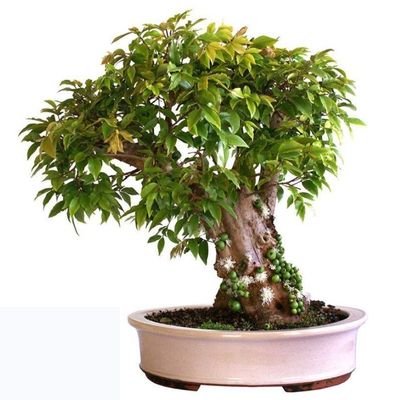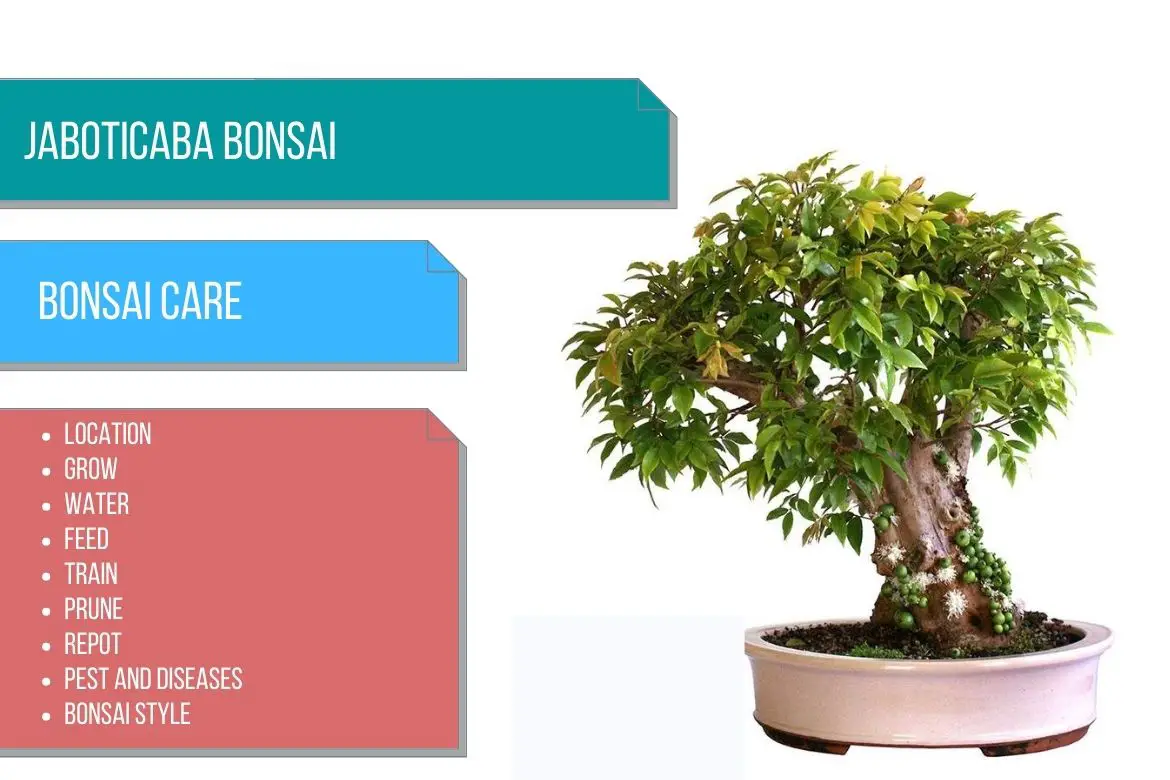
Jaboticaba / Brazilian grape tree
(Myrciaria cauliflora)
Country of Origin : South America
Bonsai Styles : Broom
Zone : 9 – 11
Jaboticaba is a small, slow-growing evergreen tree. It is a fruit-bearing shrubs that has a shape of a tree and a great number of branches.
The trunk of the tree is short, irregular and well-branched. In fact, this tree begins branching just above ground level.
The bark of the plant is smooth and usually speckled in shades of brown and grey. It flakes off in large patches giving a mottled appearance reminiscent of a tree.
The branches of the tree are light-brown and it bears opposite, oval to lanceolate, smooth edged leaves. The leaves are initially pink in color right after they open and later turn bright green as they mature.
The plant also produces clusters of flowers directly on the trunk and branches. These later grow into large, shiny, brownish red, cherry-like fruits. These fruits are edible.
The irregular but tree-like growth pattern of this plant and its small leaves make it ideal for an indoor bonsai tree. It is worth mentioning that this tree is slow grower and you will need to wait for a long time to see your jaboticaba bonsai flower – anywhere from six to twenty years.
Hence, in case you wish to admire the flowers and fruits on your bonsai tree, I would advise you to buy a mature bonsai specimen.
Read more about other bonsai trees species in : Types of bonsai tree
Best location to keep Jaboticaba bonsai tree
Can you grow Jaboticaba indoors?
Jaboticaba can be grown indoors all year round. Place it near a bright window. Avoid placing it in full sunlight. West and east facing windows are fine. If you are planning to use a south facing window, don’t keep the plant on the window. Keep it inside the room.
It can also be placed outdoors from mid spring through summer in a partially shaded location.
It can be placed in an unheated room in winter as long as the humidity level does not fall below 50%. The advisable winter temperature range is between 61°F and 75°F (16°C and 24°C). Do not let the temperature drop below 53°F (12°C).
Click here to read our detailed guide to indoor bonsai tree care.
IMP: Refer to do bonsai trees need sunlight for more indoor and outdoor bonsai location ideas. Also, refer sunlight requirements for indoor plants for more indoor gardening ideas.
Propagation of Jaboticaba bonsai tree
Jaboticaba plants can be propagated through seeds, stem cuttings or root cuttings.
The fruit of the plant contains 1-4 seeds. These seeds can germinate easily if they are sown immediately.
Stem cuttings can be propagated in the summer to early fall. Apply rooting hormone and plant the cuttings in a 50% – 50% mix of peat moss-sand. Rooting will take place in 4-5 months.
Watering Jaboticaba bonsai tree
This is a water- loving tree. In their native habitat, they are often flooded for weeks at a time and prefer moist soil that is frequently watered. You can mulch the soil to help the soil retain as much moisture as possible.
Why are my Jaboticaba bonsai leaves turning brown?
If the Jaboticaba bonsai tree dries out too much between watering sessions, its foliage will start wilting and turn brown. Water the bonsai immediately if you notice such symptoms. One more reason can be that the roots are pot bound. Repot the bonsai in such case.
Give your bonsai plenty of water during the summer months. Do not wait for the soil to dry out, you can water the tree even if the soil is slightly moist. Water less in the winter. Just keep the soil uniformly moist.
Choose water with a low mineral salt content. If possible, use as much rain water as possible.
If you do not have access to rainwater and can only use tap water, mix equal parts of tap water and distilled water for watering this bonsai.
You can even stand the hard tap water for sometime to reduce its hardness.
Read watering bonsai tree and indoor bonsai tree care for more details and also about bonsai water immersion technique.
Wiring Jaboticaba bonsai tree
Wiring is rarely necessary since the plant grows naturally like a tree. Nevertheless, you can wire the tree at any time if you choose to.
Wire only lignified branches. One- to three-year-old branches can be shaped by wiring. A guy line will be needed for older, sturdier limbs.
Read : Detailed guide on How to wire a bonsai. This extensive guide includes all the wiring techniques and Do’s and Dont’s. It will also show you other bonsai training techniques which can be achieved without using wires.
Pruning Jaboticaba bonsai tree
When to prune Jaboticaba bonsai tree?
How to prune Jaboticaba bonsai tree?
The new shoots of the Jaboticaba plant do not grow very long without changing direction. It is also common for new shoots to stop growing at around 10cm (4in) in length. Then they rest briefly before branching out again from the tip and starting to grow in two directions.
This “resting period” of the shoots is the best time to start pruning, before new twigs start to grow.
To keep the shape of the bonsai compact, the shoots can be cut back to two to four leaf pairs. From here, fresh shoots will readily emerge.
Read how to prune a bonsai to know about the right technique of pruning and more about defoliating a bonsai tree.
Repotting Jaboticaba bonsai tree
When to repot Jaboticaba bonsai tree?
Jaboticaba bonsai trees can be repotted every 2 years in early spring.
Prune the roots at the time of repotting. Depending on the health and structure of the roots, you can prune about 1/2 of the root mass. However, if in doubt, just prune almost 1/3rd of the total root mass.
Use a water retentive but well-draining bonsai soil mix. A slightly acidic soil is preferable.
You can also make a bonsai soil mix by mixing loam, peat moss and sand (1:2:2) OR fired clay particles, sand and compost (2:1:2).
Please check out how to repot a bonsai to know everything about repotting and root pruning a bonsai.
Must Read: Bonsai Soil Recipes
Must read : Choosing the right bonsai container
Feeding Jaboticaba bonsai tree
During early spring and late summer, feed the bonsai with liquid bonsai fertilizer or houseplant fertilizer every two weeks.
It is recommended to feed every four to six weeks during the winter.
Read more about bonsai fertilizer and its application. This will also give you more details on how to feed flowering bonsai trees.
Diseases and pest of Jaboticaba bonsai tree
Jaboticaba bonsai trees are susceptible to greenfly infestation.
Apply a spray of soft soapy water on the tree. (5 g of soap to 1 liter of water). Another option is to use a systemic dimethoate insecticide or a systemic organophosphate insecticide.
Scale insects, rust and canker can also cause some problems.
Please make sure you read our comprehensive guide: How to identify and treat bonsai pests and diseases is a great resource for you to see all the organic and inorganic remedies you can use.

